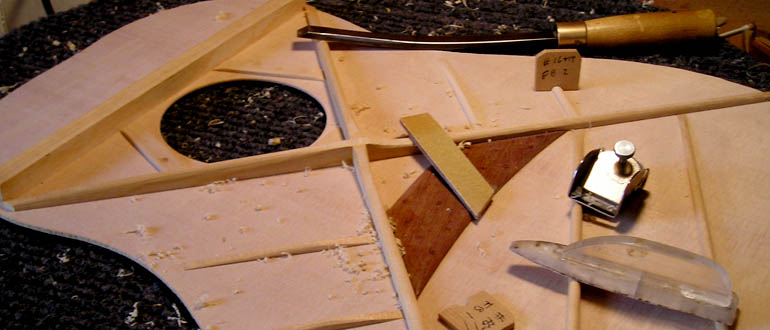SCALLOPED VS. PARABOLIC


In 1975, I was able to buy two guitars from Jon Lundberg. One was a 1937 D-28 that had been damaged in a car wreck and rebuilt at the factory in the ‘50s using the heavy braces of that time. Jon said he had reshaped the braces to be like those in 1937, and the guitar sounded better than anything I’d ever heard. Tremendous bass end.
In 1983, finances necessitated selling the ‘37, but I first decided to see what Jon had done, and do the same to my ‘60.
Unfortunately, the X brace legs had been scalloped too much, and its arms reduced too low above the cross point. The bridge had rotated so much that the bottom corners of its belly pulled up from the top. Since my 1960 D-28 had already had its X legs cut down some by a subsequent music teacher who claimed to do what Jon did, I decided that I would just taper them down to the ends, rather than cut a deeper scallop.
When I first looked in the ‘37 critically, I basically saw that Jon had used the same parabolic shapes I had seen in an engineering mechanics class at Stanford. However, instead of scalloping the belly braces, Jon had made them parabolic (!) leading me in a different direction from that of luthiers and factories who have copied the basic scalloped format. I had never seen even a picture of what those golden era tops looked like.
When an old friend and blues singer, Alice Stuart appeared at the Silver City Blues Festival in 2007, I had occasion to do some repairs on her D-18, which Jon had re-voiced in the 1960s. Interestingly, I saw that he had scalloped the belly braces (!) meaning that during the interim between then and 1975, Jon Lundberg had changed his treatment of those braces. He had most certainly discovered that parabolic belly braces gave more balanced volume across the strings.
In the 25+ years since I began shaping braces, my work has evolved and been refined many times to bring more volume, balance and clarity. In 1997, I began reshaping the surface of the bridge to reduce mass to give more headroom. Mass has inertia, and it takes work to overcome it with each pick or strum. Less mass leads to an easier, quicker response.
I also found that by flowing the main body of the bridge into the side wings, and flowing its edges down close to the top, the treble, especially, had a cleaner, brighter sound. It became obvious that the corners and ridges absorbed energy from the strings instead of allowing it to flow over the smoothed surface, and that this applies to the internal braces as well. In a way, the shaping I do is similar to streamlining airflow over an automobile in a wind tunnel.
Finally, I do not work on the braces that support the neck joint, as there is little to gain, soundwise, and much to lose.
My goal is to allow the guitar to produce its full potential while preserving structural integrity. However, balancing braces against the string tension leaves them vulnerable to the shrinking of the top and back in conditions of low humidity, and a humidifier must be used in dry times.









